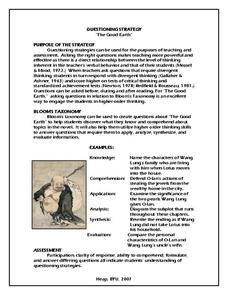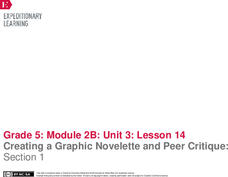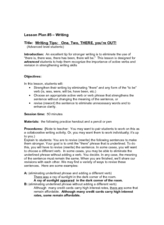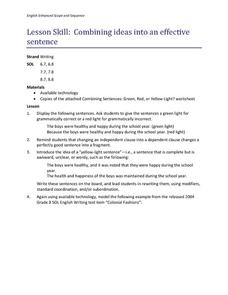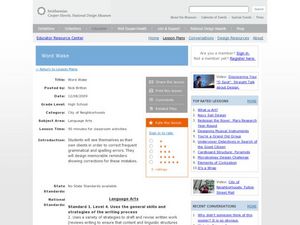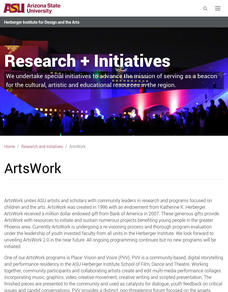Novelinks
The Good Earth: Questioning Strategy
Readers use Bloom's Taxonomy to create multi-level questions about Pearl Buck's The Good Earth.
EngageNY
Algebraic Expressions—The Distributive Property
Do your classes truly understand the distributive property? Use a demonstrative lesson to represent the distributive property in various ways. Learners solidify understanding by creating a geometric pattern for distributive...
EngageNY
Equivalent Rational Expressions
Rational expressions are just fancy fractions! Pupils apply fractions concepts to rational expressions. They find equivalent expressions by simplifying rational expressions using factoring. They include limits to the domain of the...
EngageNY
The Most Important Property of Logarithms
Won't the other properties be sad to learn that they're not the most important? The 11th installment of a 35-part module is essentially a continuation of the previous lesson, using logarithm tables to develop properties. Scholars...
EngageNY
Modeling with Exponential Functions
These aren't models made of clay. Young mathematicians model given population data using exponential functions. They consider different models and choose the best one.
EngageNY
True and False Number Sentences II
Substitution is still the method of choice to verify number sentences. The detailed lesson has young mathematicians determining conditions for when number sentences are true or false through substitution. They learn to express these...
EngageNY
Creating a Graphic Novelette and Peer Critique: Section 1
Help the class put a plan in place. With the detailed resource, pupils plan the first section of their graphic novelettes about an invention, creating and labeling their pages. Next, they work with partners to give and receive feedback...
Curated OER
Forms of Exponential Expressions
Your young physicists analyze the forms of four equivalent exponential expressions representing an amount of a radioactive material in a substance. They show how each expression is equivalent to the others and what aspects of the decay...
Curated OER
Up-to-Date Aesop
Learners translate one of Aesop's fables into a modern setting with modern language. They illustrate a fable using art supplies or illustration software on the computer.
Curated OER
The Distributive Property
MIddle schoolers use the distributive property to combine terms in six expressions. They write nine expressions in simplest form. Young scholars perform one mental math problem, describing how they would solve the multiplication mentally.
Curated OER
The Writing Tips: One, Two, There, You're Out!
Introduce your class to the importance of using active verbs in writing. Learners read sentences in which the word there is used, and identify an active verb that can be used instead. The lesson comes with a comprehensive worksheet for...
Virginina Department of Education
Combining Ideas into an Effective Sentence
Here is a lesson that is best utilized as reinforcement in identifying sentences that combine independent/dependent clauses, and phrases that are awkward, fragmented or complete. Learners use the red, yellow, and green light method...
Curated OER
Word Wake
Put your common writing errors to rest with this resource, which prompts high schoolers to create eulogies and tombstones for overused and incorrect words. They work on correcting common errors in spelling and usage mistakes in their own...
Curated OER
Character Development Through Song
Students use songs to analyze their sense of identity and self-worth. In groups, they discuss and explore their own character development and discover how far they have come in recent years. They also identify the positive and negative...
Curated OER
Writing: Narrative, Expository, Persuasive, and Descriptive
If you are interested in having a basic framework for teaching expository, narrative, persuasive, and descriptive writing, this resource may help; however, you will have to find information on the different forms of writing to share with...
Curated OER
Stuff Can - Situations That Undermine Feeling Fantastic
While more an idea than a lesson, this activity is a terrific way to discuss emotional health in your classroom. Learners are given a container in which they place slips of paper with descriptions of difficult situations (Situations That...
Curated OER
Can You Haiku?
Everyone loves haikus! They're short, quick, and fun to write! Analyze the rules and conventions of haiku. Readers interpret examples of haiku and develop a vocabulary for writing haiku. Then they compose a haiku based on a personal...
San Francisco Symphony
The American Five - Pentatonic scales in early American melodies
Through vocal warm-ups and exercises, budding musicians will attempt to grasp the five pentatonic scales, commonly used in early American songs. They'll sing and work to identify the pitch, tone, melody, and scales being expressed in the...
Curated OER
How to Write A+ Essays!
This instructional activity, which promises to improve the essays of your middle schoolers, contains a list of characteristics an essay should include. It breaks it down into the introduction, thesis statement, body, etc. There's also a...
Curated OER
Creating Plays from Children's Stories
Students explain how individual elements (e.g., plot, theme, character, conflict, etc.) comprise the structure of a play. They write an original one-act play with developed characters, specific setting, conflict, and resolution.
Curated OER
Reading Poetry
Present your class with an overview of poetry-related information. The slides are clearly organized by topic, starting with reading poetry, ending with myths, and touching on everything from the five senses to open and closed forms of...
Curated OER
Personal Poetry Books
Pupils work in the classroom and in the computer lab to produce a Personal Poetry Book.
Curated OER
Reading Fiction - Character
The goal of this lesson is to have learners understand how character is created through a combination of what they say and do, and what others say about them. In pairs, learners construct a short dialogue between a parent and child after...
Curated OER
Indirect Object Pronouns
Directly address the use of the indirect object pronouns with a lesson on how to locate them in sentences and worksheets that provide opportunities for practice using them.
